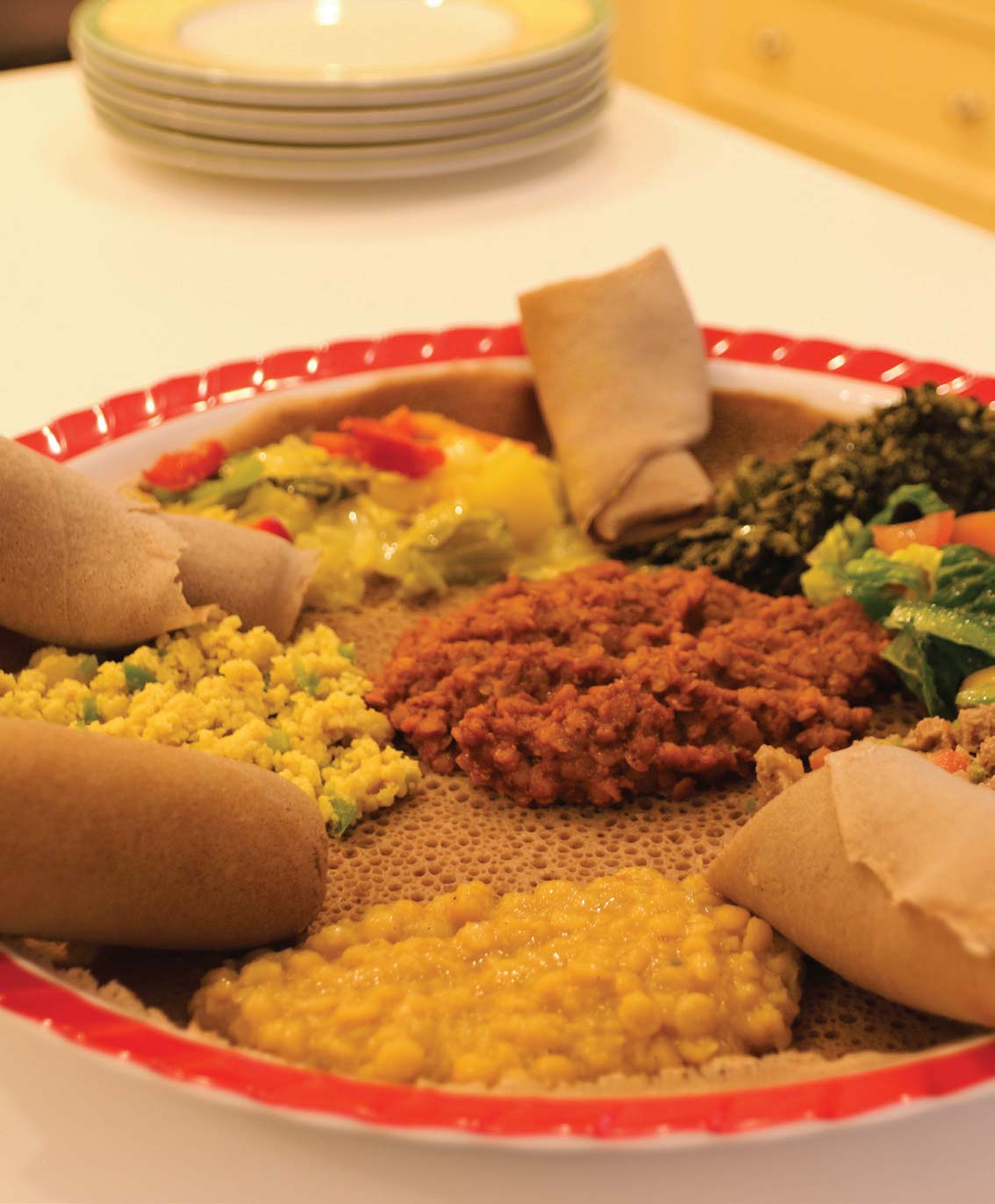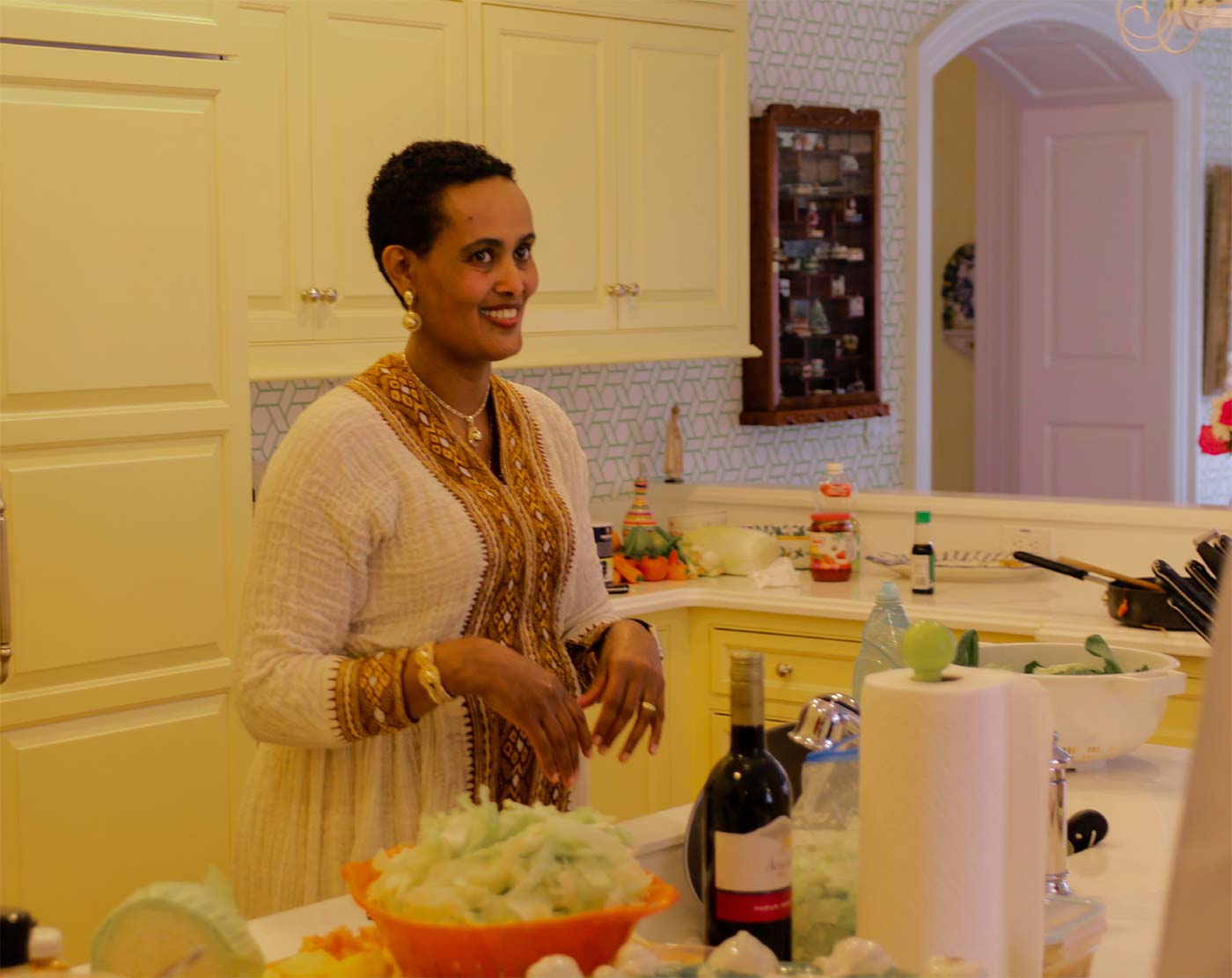FROM ETHIOPIA TO AMERICA
Food traditions from around the world converge in Columbus, and your home kitchen
It’s a Sunday afternoon and I’m in the kitchen with Netsanet Woldemedhin, a New American originally from Ethiopia. Elegant in her traditional Ethiopian hand-embroidered dress, she tells us about a spice blend from her country called berbere. It’s prepared with jalapeño peppers that are carefully washed and then ground down with a mixture of fresh herbs. The blend is set out to dry for a week and then, along with salt, another 12 to 13 spices are added to the mixture. It delivers a hot, chili-pepper- like sting to the tongue. Woldemedhin smiles, “It’s very tasty.”
Yet Woldemedhin doesn’t buy berbere here in the U.S. Her mother in Ethiopia sends it to her. It’s this relationship and regard for family and tradition that proves to be the most delicious ingredient in the meal Woldemedhin prepares for me and my friends, gathering to take part in the new Food Ambassadors program from the Ethiopian Tewahedo Social Services (ETSS) organization.
ETSS is a local nonprofit dedicated to helping immigrants and refugees new to the U.S. —New Americans, in ETSS terminology—“gain self-sufficiency in Columbus through programs and services that encourage community integration, sustained employment, education, health, and strong families.” Recently, ETSS founded the Food Ambassadors program as an extension of this mission to connect their clients to the culture of Columbus through food and native cooking traditions.
“Part of the reason I teach English classes is for the relationships,” says Kathleen M. Gibbons, social enterprise business manager at ETSS.
The Food Ambassadors program is her brainchild, which arrived after she was up one night thinking about meals she had savored during her travels abroad. Spending time with Gibbons, it’s evident how much she cares for her English as a Second Language (ESL) students and wants them to feel at home here in America. And food is one of the first ways they feel at home. She has seen firsthand how proud Woldemedhin and other refugees and immigrants are of their cooking traditions.
 A traditional plating of injera with various vegetarian dishes prepared by Woldemedhin.
A traditional plating of injera with various vegetarian dishes prepared by Woldemedhin.
“I’m almost certain all of our students have a garden or a way of growing their own food,” Gibbons says.
And that’s because food is a “love language” for the ETSS community, so growing their own peppers and garlic for their kitchens is essential to making a new home. Coming to a new country presents many challenges for immigrants, one of which is learning a language. Yet food traditions can be the constant language, and Gibbons has found it’s the one topic through which she and her students can always connect.
The Food Ambassadors program gives people like Woldemedhin a chance to express their “love language,” while educating people about their culture and building a bridge towards new friendships in their new home country. ETSS chefs come from many countries around the world, including Ethiopia, East Turkestan,
Puerto Rico, Mexico, Liberia, Ghana, Haiti, Nepal and Macedonia. And each chef has an amazing story to tell.
When you take part in the Food Ambassadors program you can request a chef from whichever country speaks to you. All dietary restrictions (and spice levels) are fully adhered to and the ETSS chefs come to your kitchen and use local, fresh organic ingredients as much as possible. ETSS also has a community garden on site where students grow their own vegetable plots for the season, and the Food Ambassadors will also feature fresh vegetables from the garden in their meals.
Woldemedhin immigrated to the U.S. when she was in her late 30s. When I ask her what she loves about cooking she smiles for a moment. Earlier in our conversation she told me how Ethiopian girls learn to cook by studying their mothers and learning from them. She described how, from the age of 8, she watched her mother in the kitchen. Over time, after she left her mother’s home and started her own, she learned more about cooking from cookbooks and TV shows. When she came to America, preparing homemade injera, a traditional Ethiopia bread made with teff, was hard because the climate in Ohio was so different from Ethiopia, but she persisted. And succeeded.
So when she finally replies, her bright, beautiful smile evocative of the joy she feels inside for food and cooking, I know why her fresh injera and red lentils are so delicious—they’re filled with love.
“After I cook,” she says, “ I love sharing with the people. When I see they are happy it makes me happy.
TATJANA BOZHINOVSKI came to America with her family when she was young. She remembers watching Americans put butter on their bread, wondering, “Why do they do that?” In Macedonia, she says, “You just eat the bread.”
Bozhinovski shares this innate attention to detail in the meals she prepares for the Food Ambassadors program, listing each dish she’ll prepare for an upcoming private dinner with guests. First up is maznik, a hand-stretched dough as thin as phyllo served with feta, and a cucumber and yogurt salad with fresh garlic and chopped walnuts served in little bowls and eaten with a few sips of a Macedonia brandy.
Next comes ajvar, roasted red peppers that are ground down and then baked. The traditional Macedonia spread is served on a baguette with a sprinkling of feta. And the peppers are local. Every year Bozhinovski and her Macedonia community order bushels of red peppers from an Amish farmer in Mansfield. Last year, Bozhinovski and her mom preserved 10 bushels—40 cans—of red peppers for the winter.
The star of the show is Bozhinovski’s turli tava, a mixed vegetable casserole featuring the freshest vegetables from the garden including okra, onions, garlic, zucchini, tomatoes, Hungarian peppers, carrots and eggplants. Mixed with beef and topped with potato wedges and sliced tomatoes, it’s a favorite traditional Macedonia dish for her husband and son.
“You get the beautiful taste of the vegetables,” she says.
And like Netsanet, Bozhinovski has a secret spice. It’s called vegeta.
“I don’t know how to cook with salt,” she says, because in her cooking tradition she always uses vegeta, a mixture of dried vegetables with salt, pepper and a little paprika. You can find it in Macedonia markets and Bozhinovski grew up using it in her cooking.
For dessert, Bozhinovski prepares oblanda, a wafer filled with simple syrup and ground walnuts, served with traditional Macedonia Turkish coffee. Dessert is always accompanied by coffee, Bozhinovski says.
Visit ediblecolumbus.com for more stories from the Food Ambassadors program. To learn more and to book your own private meal, contact Director of Development Keri Allen-Hogan at Keri.AllenHogan@ethiotss.org.




